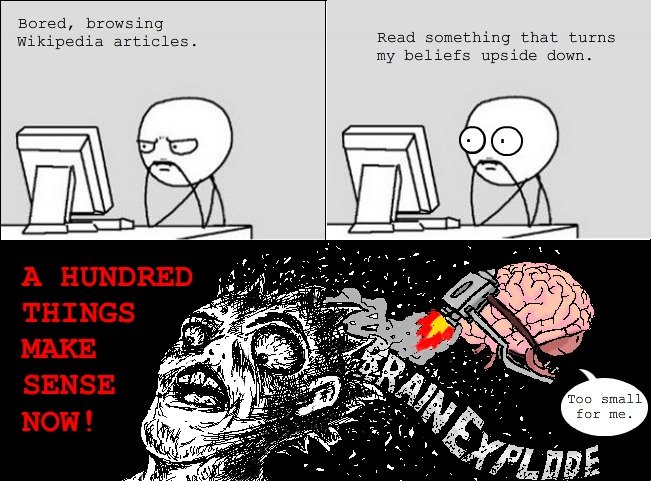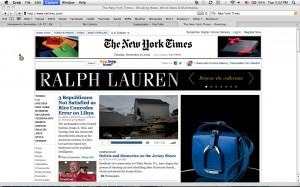I like the idea of reflecting back upon all that I have learned over the course of this semester because I can easily get lost in all of the information that has been gleaned. When thinking back upon my first ideas of digital writing, I thought like most people digital writing was limited to blogs, emails, and web coding. What I have come to realize now that I have come through the class is not only the immensity of the subject (almost all forms writing in the 21st century), but the influence and change that has occurred through the way we view and comprehend each subject (Insert MindBlown.gif).
That, I believe, is the most important part about this course. Whether we realize it not, we are all influenced by the subtleties that exist in creating a piece of digital writing, which can extend from the tiniest of font and color choices to the overwhelming themes of repetition that can engulf an image. Being able to analyze and decode an image is part of being a twenty-first century individual. Technology has not only changed the way we live, but continues to shape the way we think. The ideologies and principles have remained the same, but the way that they are disseminated through mass communication have forever changed.
And Jenkins’ article, “Confronting the Challenges of Participatory Culture: Media Education for the 21st Century” was a main part of decoding these facts. In it, he elaborates on a set of eleven social skills which help in understanding of this concept of digital writing. I will transfer my understandings of the these skills upon my workings over the semester.
- Play— the capacity to experiment with one’s surroundings as a form of problem-solving.
- I exhibited the use of play in almost every endeavor of the class. I have never before edited a wiki page or created a video slideshow for the internet. With more programs developing user-friendly software with intuitive designs for the common layman, there becomes less issues in problem solving. However, in my case with Project 2, I encountered the problem of compatibility between software. But it all worked out through trial and error.
- Performance— the ability to adopt alternative identities for the purpose of improvisation and discovery
- To some extent this skill was demonstrated in the identification of our alter-egos for Project 3 when we analyzed our current virtual selves. We all have chosen specific ways of representation before our given audiences whether we realize it or not.
- Simulation— the ability to interpret and construct dynamic models of real-world processes
- I believe we showed this skill in Project 3 when we took a digital approach of how an job recruiter would go through the process of checking on the applicant through internet search engine searches and the analysis of resumes.
- Appropriation— the ability to meaningfully sample and remix media content
- This skill was obviously shown in my presentation of Project 2 where I remix the media content of the description for my voice with the slideshow that I had created to meaningfully display the content.
- Multitasking— the ability to scan one’s environment and shift focus as needed to salient details.
- Multitasking is a skill that can be completely harnessed through the use of digital media. I remember one cell phone provider advertising the use of being able to surf and talk at the same time. Indeed, I am using the details of this assignment to guide my response as I look back on the article in question. This back and forth style allows for almost all material to used efficiently.
- Distributed Cognition— the ability to interact meaningfully with tools that expand mental capacities
- I feel this is a big part of most of the programs and websites out there today. Their competitiveness relies around two goals: efficiency and intuitiveness. In Project 1, the idea of a wiki worked well in creating a web page. The class was able to navigate and “interact meaningfully” with the presented tools to help explain the concept of Digital Media.
- Collective Intelligence— the ability to pool knowledge and compare notes with others toward a common goal
- I think no other project exhibited this trait that ing Project 1. It required this very skill and we all had a class on how we might learn to cooperate and pool knowledge into our Wiki.
- Judgment— the ability to evaluate the reliability and credibility of different information sources
- In every project, we incorporated the use of hyperlinks which not only add credibility to our work, but give credit back to the originator of the source.
- Transmedia Navigation— the ability to follow the flow of stories and information across multiple modalities
- This ability encapsulate the entire semester. We, as a class, transferred our ideas of Digital media through a Wiki page into Visual Postcard. The idea was the same, but the mode of communication had changed.
- Networking— the ability to search for, synthesize, and disseminate information
- This skill was used almost every day. I will refer to the “Rhetoric on the Town” postings where we searched for an image and then analyzed the information according to our curriculum. Following, we “disseminated” the results onto our blogs for our classmates to read as well.
- Negotiation— the ability to travel across diverse communities, discerning and respecting multiple perspectives, and grasping and following alternative norms.
- I remember one specific time when we were broken into groups during Project one and given the task of analyzing a set of articles. Many people had some differing takes on the subjects and themes, so we all had to come together and come to a way of working together and post our results.


